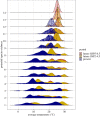Present and future distribution of bat hosts of sarbecoviruses: implications for conservation and public health
- PMID: 35611534
- PMCID: PMC9130791
- DOI: 10.1098/rspb.2022.0397
Present and future distribution of bat hosts of sarbecoviruses: implications for conservation and public health
Abstract
Global changes in response to human encroachment into natural habitats and carbon emissions are driving the biodiversity extinction crisis and increasing disease emergence risk. Host distributions are one critical component to identify areas at risk of viral spillover, and bats act as reservoirs of diverse viruses. We developed a reproducible ecological niche modelling pipeline for bat hosts of SARS-like viruses (subgenus Sarbecovirus), given that several closely related viruses have been discovered and sarbecovirus-host interactions have gained attention since SARS-CoV-2 emergence. We assessed sampling biases and modelled current distributions of bats based on climate and landscape relationships and project future scenarios for host hotspots. The most important predictors of species distributions were temperature seasonality and cave availability. We identified concentrated host hotspots in Myanmar and projected range contractions for most species by 2100. Our projections indicate hotspots will shift east in Southeast Asia in locations greater than 2°C hotter in a fossil-fuelled development future. Hotspot shifts have implications for conservation and public health, as loss of population connectivity can lead to local extinctions, and remaining hotspots may concentrate near human populations.
Keywords: SARS-like coronavirus; climate change; diversity; ecological niche models; forecasting.
Conflict of interest statement
We declare we have no competing interests.
Figures



References
-
- IPBES. 2020. Workshop report on biodiversity and pandemics of the Intergovernmental Platform on Biodiversity and Ecosystem Services. Bonn, Germany: IPBES.
Publication types
MeSH terms
LinkOut - more resources
Full Text Sources
Research Materials
Miscellaneous

